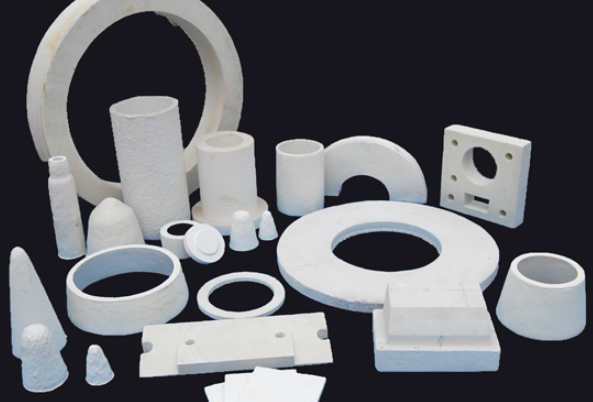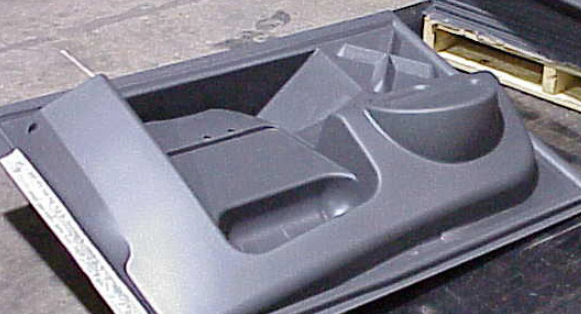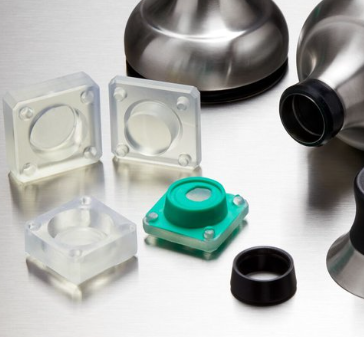Vacuum molding creates durable, long-lasting objects, but they’re not permanent and can degrade over time under certain conditions.

Materials Used in Vacuum Molding
Vacuum molding, a versatile and efficient manufacturing process, primarily uses thermoplastics due to their ability to reshape when heated. This section explores the commonly used materials and their distinct properties and durability.
Commonly Used Plastics and Polymers
ABS (Acrylonitrile Butadiene Styrene): Known for its strength, ABS is a popular choice in vacuum molding. It withstands physical impacts and chemical corrosion, making it ideal for automotive parts and consumer goods. The melting point of ABS ranges between 200°C to 250°C, allowing for easy molding.
Polycarbonate: Renowned for its transparency and heat resistance, polycarbonate is often used for products requiring clarity, like protective coverings and eyewear. Its high resistance to impact and temperature (up to 147°C) adds to its appeal.
PVC (Polyvinyl Chloride): PVC’s versatility is evident in its application in both rigid and flexible forms. Rigid PVC, used in construction, exhibits excellent mechanical strength and resistance to chemicals and weathering. Flexible PVC finds its use in medical equipment and cables.
Polyethylene: Including varieties like HDPE and LDPE, polyethylene is known for its chemical resistance and toughness. HDPE, with higher rigidity, suits containers and piping, while LDPE, more flexible, is suitable for film applications and bags.
Material Properties and Durability
Mechanical Strength: Materials like ABS and polycarbonate offer high tensile strength, essential for products subjected to physical stress.
Chemical Resistance: Polyethylene and PVC excel in environments exposed to chemicals, reducing the risk of degradation.
Thermal Stability: Materials’ ability to withstand high temperatures without losing shape is crucial. Polycarbonate, for instance, maintains its properties up to 147°C.
Life Expectancy: The durability of vacuum molded products largely depends on material choice. For example, PVC and ABS can last for years under proper conditions, ensuring long-term functionality.
The Process of Vacuum Molding
Vacuum molding, also known as thermoforming, is a process where a plastic sheet heats until pliable, then forms over a mold with the aid of vacuum suction. This section delves into the detailed steps involved in this process and the factors influencing the molding quality.
Step-by-Step Procedure
- Heating the Plastic Sheet: Initially, workers load a thermoplastic sheet into the machine. They heat it to a specific temperature where it becomes soft and moldable. The heating temperature varies based on the material type. For instance, ABS typically heats to around 200°C to 250°C.
- Placing the Mold: Once the plastic softens, they position it over a mold. This mold can be of various materials, including aluminum or wood, depending on the desired finish and production volume.
- Applying Vacuum Pressure: The machine then applies vacuum pressure between the mold and the plastic sheet. This pressure, usually around 14 psi (pounds per square inch), forces the plastic to conform to the mold’s shape.
- Cooling and Solidification: After forming, the plastic cools and solidifies into the desired shape. Cooling times can vary, but efficient cooling systems can significantly speed up this step, enhancing production speed.
- Trimming and Finishing: The final step involves trimming excess plastic and finishing the product to meet quality standards. The trimming process can be manual or automated, depending on the scale of production.
Factors Influencing the Quality of Molding
- Material Quality: The choice of material significantly impacts the final product. High-quality plastics ensure better finish and durability.
- Mold Precision: The accuracy of the mold design directly influences the product’s fidelity. Advanced CNC machining offers high precision for complex designs.
- Temperature Control: Precise temperature control is crucial for achieving the right material pliability without causing degradation.
- Vacuum Pressure Consistency: Consistent vacuum pressure ensures uniform material distribution, crucial for products requiring high structural integrity.
- Cooling Rate: A controlled cooling rate prevents warping and maintains the shape integrity of the molded product.

Durability and Longevity of Vacuum Molded Products
Vacuum molding, a process widely used in various industries, produces items known for their durability and longevity. The life expectancy of vacuum molded products depends on several factors, including the materials used, the molding process, and the application environment.
Life Expectancy of Vacuum Molded Items
- Material Choice: The type of plastic used in vacuum molding plays a significant role in determining the product’s lifespan. For example, ABS plastic is known for its strength and durability, often lasting for years under normal use conditions.
- Thickness and Density: The thickness and density of the molded plastic also contribute to its longevity. Thicker and denser materials are generally more resistant to wear and tear.
- Quality of Manufacturing: High-quality manufacturing processes, including precise temperature control and accurate mold designs, result in products with enhanced durability.
- Usage Conditions: The environment in which the product is used greatly affects its lifespan. Items used outdoors or in harsh chemical environments may have a shorter lifespan compared to those used in controlled indoor settings.
Factors Affecting the Durability
- Material Degradation: Over time, plastics can degrade due to exposure to sunlight (UV radiation), temperature fluctuations, and chemical exposure. Materials like polycarbonate are more resistant to UV radiation, thus offering longer life in outdoor applications.
- Physical Stress: The amount and type of physical stress, like impact, pressure, or constant use, can impact the product’s durability. Materials with high impact resistance, such as ABS, can withstand more stress.
- Manufacturing Defects: Imperfections during the manufacturing process, such as uneven thickness or inadequate cooling, can lead to weak spots in the product, reducing its overall life expectancy.
- Maintenance and Care: Regular maintenance and proper care can significantly extend the life of vacuum molded products. This includes cleaning, protecting from extreme conditions, and avoiding misuse.
Comparative Analysis: Vacuum Molding vs. Other Molding Techniques
Vacuum molding, a process of shaping plastic by heating it and using vacuum pressure to mold it around a form, is one of several plastic molding techniques. Comparing vacuum molding to other methods like injection molding and blow molding helps in understanding its unique advantages and limitations.
Strengths and Weaknesses of Vacuum Molding
Strengths:
- Cost-Effectiveness: Vacuum molding generally requires lower tooling costs compared to injection molding. This makes it more cost-effective for small to medium production runs.
- Design Flexibility: It allows for a wide range of designs and is particularly suitable for large parts.
- Rapid Prototyping: The process is faster in setting up and producing prototypes, allowing for quicker design iterations.
- Material Efficiency: Vacuum molding produces less material waste, as excess plastic can often be re-used.
Weaknesses:
- Limited Detail: Compared to injection molding, vacuum molding is less capable of producing highly detailed parts.
- Material Restrictions: It is predominantly limited to thermoplastics, whereas processes like injection molding can use a wider range of materials.
- Thickness Variation: The parts may have uneven thicknesses, especially in deeper molds.
Cost-Effectiveness and Efficiency
- Reduced Tooling Costs: The molds used in vacuum molding are typically less expensive than those required for injection molding. This is particularly significant for low-volume production.
- Energy Consumption: Vacuum molding consumes less energy per cycle compared to injection molding, as it does not require the plastic to be injected under high pressure.
- Production Speed: While vacuum molding is generally faster than other methods in terms of setup and turnaround time, it may be slower per piece, especially compared to the high-speed production capability of injection molding.
- Material Costs: The cost of materials used in vacuum molding can be lower, and the process allows for the use of recycled materials, further reducing costs.

Maintenance and Care of Vacuum Molded Products
Proper maintenance and care are crucial for extending the lifespan of vacuum molded products. Understanding the best practices for maintaining these products and addressing common issues can significantly enhance their durability and functionality.
Best Practices for Prolonging Product Life
- Regular Cleaning: Regularly clean vacuum molded products using mild detergents and soft cloths. Avoid harsh chemicals that can degrade the plastic.
- Avoid Prolonged Sun Exposure: Protect the items from prolonged exposure to sunlight, which can cause fading and weaken the material due to UV radiation.
- Proper Storage: Store the products in a cool, dry place to prevent warping and deformation. Extreme temperatures can adversely affect plastic materials.
- Handle with Care: Despite their durability, handle these products with care to avoid scratches and dents. This is particularly important for items with a high-gloss finish.
- Check for Stress Points: Regularly inspect for any signs of stress or cracking, especially in areas that bear weight or undergo regular use.
Common Issues and Solutions
- Warping: If a product warps, it may be due to excessive heat exposure. To prevent this, avoid placing items near heat sources or in direct sunlight.
- Scratches: For minor scratches, buffing the surface with a fine-grade sandpaper or a plastic polish can help. For deeper scratches, it may be necessary to replace the part.
- Cracking: If cracking occurs, it’s often due to physical impact or stress. To repair, use a suitable plastic adhesive or, if the damage is extensive, consider replacing the part.
- Color Fading: Protect colored plastics from fading by using UV-protective sprays and avoiding direct sunlight.




